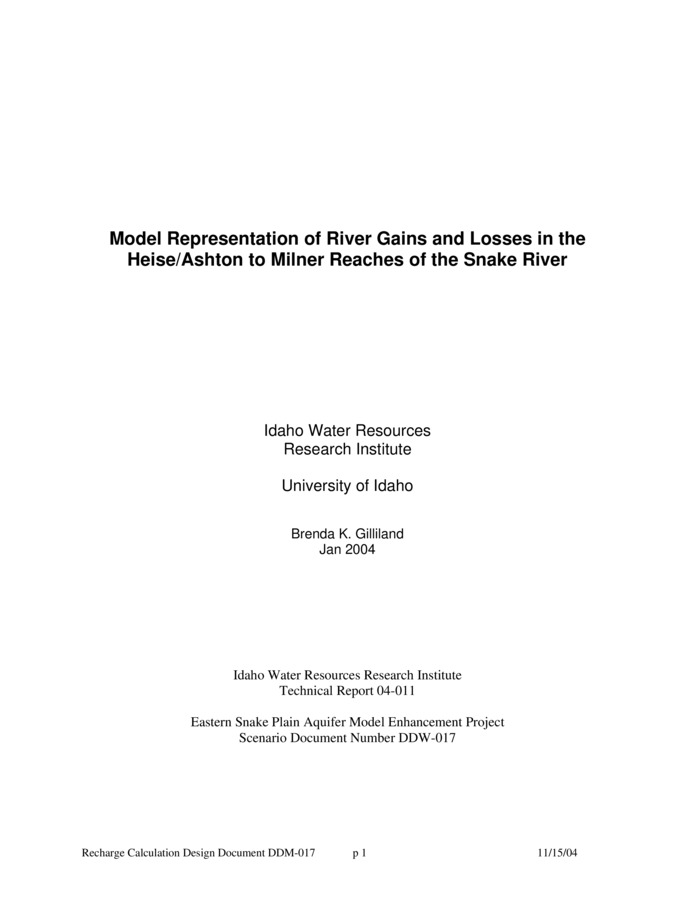PDF
Model representation of river gains and losses in the Heise/Ashton to Milner reaches of the Snake River. Technical report 04-011. Scenario document number DDW-017 Item Info
- Title:
- Model representation of river gains and losses in the Heise/Ashton to Milner reaches of the Snake River. Technical report 04-011. Scenario document number DDW-017
- Authors:
- Gilliland, Brenda K.
- Date:
- 2004-01
- Description:
- Design documents are a series of technical papers addressing specific design topics on the eastern Snake River Plain Aquifer Model upgrade. Each design document will contain the following information: topic of the design document, how that topic fits into the whole project, which design alternatives were considered and which design alternative is proposed. In draft form, design documents are used to present proposed designs to reviewers. Reviewers are encouraged to submit suggested alternatives and comments to the design document. Reviewers include all members of the Eastern Snake Hydrologic Modeling (ESHM) Committee as well as selected experts outside of the committee. The design document author will consider all suggestions from reviewers, update the draft design document, and submit the design document to the SRPAM Model Upgrade Program Manager. The Program Manager will make a final decision regarding the technical design of the described component. The author will modify the design document and publish the document in its final form in .pdf format on the SRPAM Model Upgrade website. Final model documentation will include all of the design documents, edited to ensure that the "as-built" condition is appropriately represented. Understanding gains and losses of the Snake River is an important aspect of conjunctive management of the water resources of southern Idaho. Quantifying the surface and groundwater exchange is fundamental to management and to the development of technical tools such as the Snake River Plain aquifer model. The exchange of water between the Snake River Plain aquifer and the Snake River is a primary target in the calibration of the model. The model will ultimately be used to guide aquifer and river management. The purpose of this document is to describe the gains and losses of the upper reaches of the Snake River within the bounds of the Snake River Plain aquifer. This document is also intended to give readers a sufficient understanding of the uncertainties in the methods so that they may infer a level of confidence in the results. The presented analyses are described for all river reaches defined by gaging stations for reaches above Milner on the Snake River continuously or nearly continuously operational during the 1980 through 2002 period (Figure 1). Some adjacent reaches may later be aggregated as determined to be appropriate during aquifer model calibration. This period was selected to match the calibration period of the Snake River Plain aquifer model. The gains and losses described in this document are intended to represent the calibration targets for the aquifer model. The description of the analysis in each reach is intended to assist in assignment of a confidence in that target.
- Subjects:
- aquifers computer models
- Location:
- Eastern Snake Plain Aquifer; Southern Idaho
- Idaho County:
- Elmore County
- Latitude:
- 43.63
- Longitude:
- -111.67
- Additional Lat-Long:
- 42.52, -114.01
- Collection:
- Boise Basin
- Series:
- ESPAM
- Source:
- Idaho Water Resources Research Institute, University of Idaho
- Identifier:
- IWRRI Number 2004011
- Publisher:
- Idaho Water Resources Research Institute, University of Idaho
- Contributing Institution:
- University of Idaho
- Type:
- Text
- Format:
- application/pdf
- Cataloger:
- KIT
- Language:
- eng
Source
- Preferred Citation:
- "Model representation of river gains and losses in the Heise/Ashton to Milner reaches of the Snake River. Technical report 04-011. Scenario document number DDW-017", Idaho Waters Digital Library, University of Idaho Library Digital Collections, https://www.lib.uidaho.edu/digital/iwdl/items/iwdl-ddw_017reachgainlossfinal.html
Rights
- Rights:
- In copyright, educational use permitted. Educational use includes non-commercial reproduction of text and images in materials for teaching and research purposes. For other contexts beyond fair use, including digital reproduction, please contact the University of Idaho Library Special Collections and Archives Department at libspec@uidaho.edu. The University of Idaho Library is not liable for any violations of the law by users.
- Standardized Rights:
- http://rightsstatements.org/vocab/InC-EDU/1.0/

